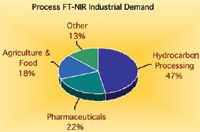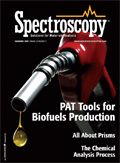Article
Spectroscopy
Spectroscopy
Market Profile: Process FT-NIR
Fourier transform–near infrared spectroscopy, generally referred to as FT-NIR, is a rapidly growing process analytical technique. The technique has a number of inherent advantages over other spectroscopy techniques for online monitoring, and is now used widely across a number of contrasting industries.
Fourier transform–near infrared spectroscopy, generally referred to as FT-NIR, is a rapidly growing process analytical technique. The technique has a number of inherent advantages over other spectroscopy techniques for online monitoring, and is now used widely across a number of contrasting industries.
The requirements of almost any online process instrument include reliability, rapid analysis, and consistent performance. An FT-NIR spectrometer relies on a much less complex mechanical design than traditional dispersive NIR instruments, which allows fewer opportunities for something to go wrong. FT-based spectroscopy instruments analyze the entire spectrum simultaneously, which is useful in analyzing continuous flows, or monitoring changing mixtures. NIR also tends to be better for quantitation, whereas mid-infrared spectroscopy generally is more suited to qualitative analyses, although there are numerous exceptions to both.

Process FT-NIR Industrial Demand
Although process FT-NIR is applied significantly across a number of contrasting industries, it is in the petroleum and hydrocarbon processing industry where it is by far most heavily used. All of the inherent advantages of the technique are needed to monitor various refinery processes in real-time, which is even more important given health and safety concerns in such facilities. The global market for process FT-NIR was worth over $50 million in 2007, and should see double-digit growth, thanks to increased activity in the petroleum and biofuels industry, as well as continued strong growth in the pharmaceutical industry.
The foregoing data were based on SDi's Market Analysis and Perspectives (MAP) Report program. For more information, contact Stuart Press, Vice President — Strategic Analysis, Strategic Directions International, Inc., 6242 Westchester Parkway, Suite 100, Los Angeles, CA 90045; (310) 641-4982, fax: (310) 641-8851, www.strategic-directions.com.
Newsletter
Get essential updates on the latest spectroscopy technologies, regulatory standards, and best practices—subscribe today to Spectroscopy.




